|



Elad FDM-S3
Sometime in 2017 it
was announced that Elad would build a successor to the well-known
Elad FDM-S2. After some time it was actually there! The Elad FDM-S3.
But unfortunately only as a beta device for testers. I asked Elad if
they would provide me with a test unit. Unfortunately my request was
not answered. Through a hobby colleague who had business contacts
with Elad, I nevertheless got an S3. This device leaned heavily on
the S2 in terms of design. With its rounded edges, it almost passed
for a design icon. A look under the hood showed a neatly cleaned up
circuit board with slots for bandpass filters. For reasons unknown
to me, this device was not further developed.
The new Elad
FDM-S3
It was then quiet
around the S3 for a long time! Only in 2020 was this device
discussed again in various Internet forums and Facebook groups. The
pictures shown there showed a completely different device. Elad had
decided on a different design for the device's exterior. The device
now looks professional and is very robustly built. After an official
order via email, I received the new FDM-S3 in January 2020.
.jpg)
The
S3 was shipped by DHL courier from Italy and was here in less than
24 hours. After unpacking, I finally held the S3 in my hands. First
impression: Cleanly manufactured and a decent weight! The front as
well as the back are made of aluminum, the blue covers are made of
metal. After opening the case, I was impressed. The electronics are
built into two milled aluminum blocks. Even the bandpass filters
have an RF dense housing. Rarely do you see such build quality!
The S3 is connection friendly! On the back are connectors for:
|
-- Gnss
antenna input with 3.3V power supply (GPS)
-- HF-1 for LMK and 6m
-- HF2 for LMK and 6m with 5V power supply for one active
antenna
-- VHF for FM/UKW with 5V power supply for one active
antenna
-- 10MHz reference input
-- 10MHz reference output
-- 2x DC in/out (power pole)
-- EXT/IO for future extensions. E.g. external preselector
-- USB3.0 connector
-- Preparation for antenna connection of the DCM (downconverter).
|
The main
features of the Elad FDM-S3
|
-- Frequency range: HF: 9KHz - 54MHz / VHF:
54MHz - 108MHz / VHF,UHF, SHF: 108MHz -
4000MHz (with optional downconverter)
-- Spectrum bandwidths: 192kHz, 384kHz,
1.5MHz, 3MHz, 6MHz, 12MHz, 24MHz
-- Built-in FM bandpass filter for the range
68.88MHz - 108MHz
-- 16bit ADC with 122.88MHz
-- Reference Clock Manager Module. Allows
two different ways of frequency
stabilization. Gnss (via satellite signal)
or 10MHz reference signal.
-- Internal temperature compensated crystal
oscillator -TCXO- or oven controlled crystal
oscillator -OCXO- (option).
-- 2x Power-Pole DC connectors
-- Prepared for DCM (downconverter)
installation
-- Built-in USB hub for:
-- control with SW2 software and others.
-- USB Com port for the Reference Clock
Manager Module.
-- USB Com port for the internal Gnss module.
For control with appropriate progams.
-- Dimensions: 230 mm x 60 mm x 155 mm (WxHxD)
-- Weight: 2.15kg (without downconverter)
-- Compatible software: Elad SW2 & SDR
Console V3 (as of July 2022)
Scope of delivery:
-- ELAD FDM-S3
-- USB3 cable
-- DC power cable with Power-Pole connector
-- 3x adapter SMA to BNC
-- Gnss antenna for satellite reception (only
if the S3 was ordered with the OCXO)
-- USB stick with software and manuals
-- Measurement protocol of the OCXO (Oven
Controlled Crystal Oscillator) and the TCXO
(Temperature Compensated Crystal Oscillator)
of the S3. |
Installation and
operation
On the supplied USB
stick are all the necessary drivers and programs for installation.
Nothing has to be downloaded from the Internet. The S3 was not
recognized after connecting to a USB3 hub. Only after direct
connection to the PC, the installation worked smoothly. Afterwards
the software SW2 was installed. The device started without problems.
Tip: All installations should be done as administrator. Otherwise,
the device may not start! After the installation and start of the
S3, the device manager should show "ELAD FDMS3". If you still see
"ELAD FX3 USB BootLoader Device" after trying to start the device,
something is wrong.

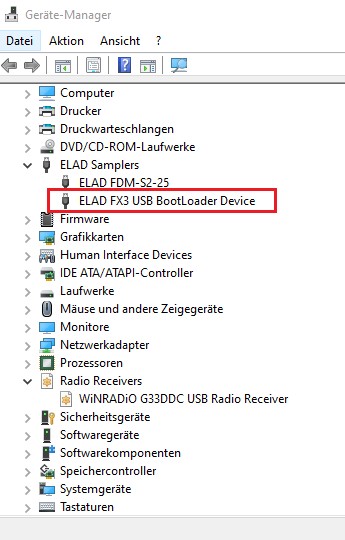
After turning the S3
on and off on the device, I noticed a strange behavior of the small
on/off button. If it is only lightly touched, it immediately
switches on! This is not normal behavior for an on/off switch.
Normally, the switch must be pressed until it makes an audible "click",
and then it comes to the switching operation. After asking Elad,
they confirmed this problem. Obviously the wrong switch is installed!
Block diagram
of the S3 front end
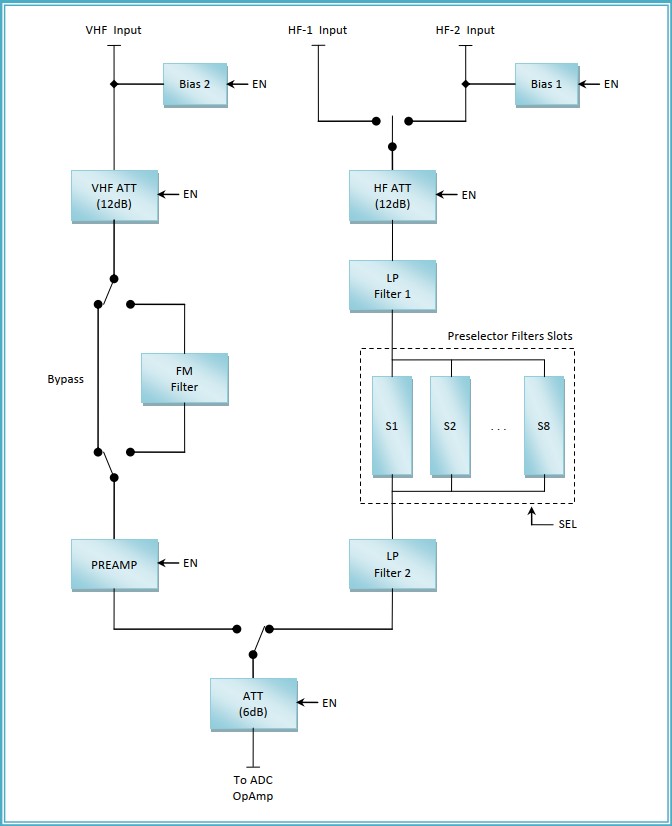
The bandpass filters
The S3 is shipped without RF bandpass filters as standard. Only the
bypass board is built in. All frequency ranges up to 54Mhz pass this
bypass. Of course the S3 can be operated without bandpass filter,
because the large signal behavior with IP3 +30dBm should be good
enough. Unfortunately, it turned out that the ADC clipping indicator
of the SW2 lit up very often when it was operated at high power
antennas. This can be remedied by using the optional bandpass
filters. In the frequency ranges where the bandpass filters are
active, the ADC clipping indicator practically does not light up
anymore and the noise floor is a few dB lower. Unfortunately, Elad
offers bandpass filters that are mainly tailored to the amateur
radio ranges! The other frequency ranges are almost not covered. A
"General Coverage" bandpass filter set was not available, to the
regret of many broadcast SWL's. So I ordered those bandpass filters
that appealed to me the most.
|
-- High Pass 1700KHz
(FHP1M7-1)
-- Band Pass 4.8 - 6.2MHZ
(FBP60-1)
-- Band Pass 13 - 21MHz
(FBP1321)
-- Band Pass 21 - 35MHz
(FBP2135)
|
Bandpassfilters
from
Elad
.jpg)
With the bandpass
filters mentioned above, I used the S3 for a while. Unfortunately,
the joy did not last long. Because I do not only listen to amateur
radio, but am mainly active outside the amateur bands, a solution
had to be found.
Bandpass filter from Ernst Kirschbaum (DL2EBV)
Ernst is a specialist in preselectors and software. So he was the
right contact for such bandpass filters. It did not take long and
words were followed by deeds. Ernst set about developing a general
coverage bandpass filter set for the S3. Not only for the S3, these
bandpass filters can also be used with the Elad FDM-DUOr and Elad's
external preselectors. It is obvious that the development of such
filters takes a lot of time. Every single ferrite ring has to be
wound by hand. Afterwards everything has to be measured and adjusted.
After some months, at the DX-Camp in Solingen, I could receive the
"DL2EBV bandpass filters".
With this bandpass filter set from Ernst, the whole shortwave range
up to 30MHz can now be filtered.
Since mid-June 2022, Elad is pleased to offer Ernst's filters on
their website. "Set
di filtri passa band DL2EBV (Kit FBP0530)"
Pictures below: The installation of the new DL2EBV filters in the
S3.
Passbands of the
DL2EBV bandpass filters

Below: Setting values of the DL2EBV bandpass filters in the SW2
software.
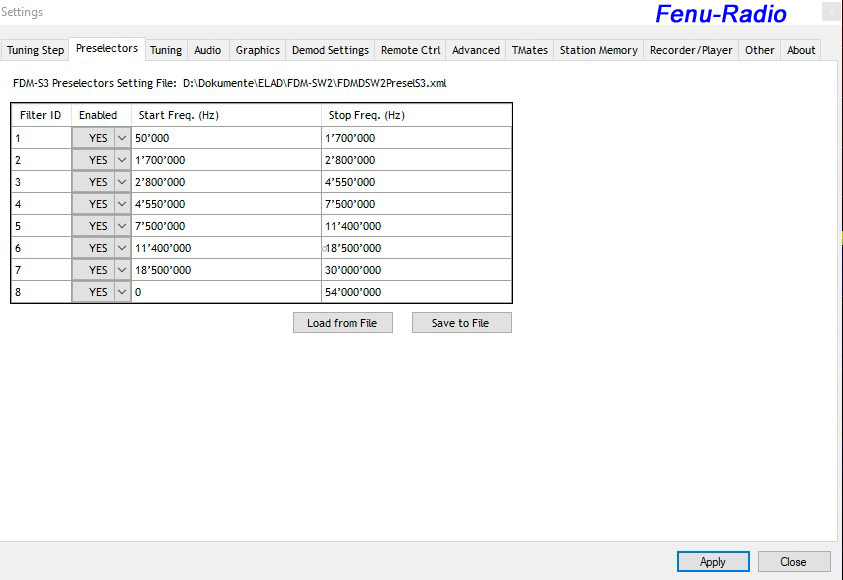
Below: DL2EBV bandpass filter ranges shown in SW2 software. Click on
the image to enlarge.
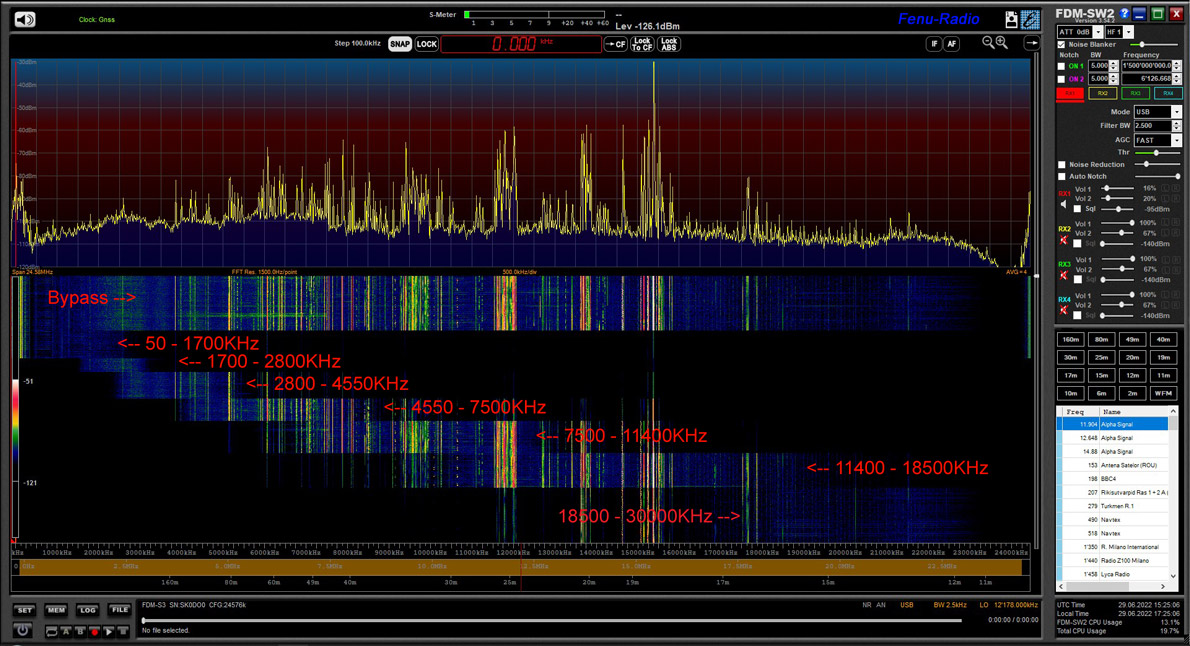
Experiences with the S3 on long, medium and short wave (9 KHz -
54MHz)
The S3 is able to display a spectrum up to 24MHz wide. To make this
possible, the S3 should be connected to a modern PC with enough RAM,
fast processor and fast SSD. Otherwise, it can happen that the PC is
overloaded and everything starts to stutter. This very large visible
spectrum makes sense only for the short overview on the shortwave.
You can't really work with it, because the single stations are not
visible.
I compared the S3 several months with my reference SDR, the Winradio
G33DDC Excalibur Pro. Most of the time I used the software that
comes with the device. Reception-wise both SDR's give nothing to
each other. Sensitivity and large signal behavior are similarly
good, whereby the ADC clipping (overdriving of the AD converter) of
the S3 was somewhat better than with the Winradio. The ADC clipping
indicator barely lights up. However, only when the bandpass filters
were installed and activated. Using the bandpass filters also makes
the reception less noisy because the ADC only has to process a
portion of the frequency spectrum.
Many comparisons from VLF to VHF brought the realization that Elad
has done a great job with the S3! The reception differences to the
Winradio G33DDC are zero! The only small difference is the audio
playback of the two programs. But that relativizes itself after a
short time of listening. When operating the S3 with the original SW2
software, it was noticed that there is no preselector bypass
function on the software interface to be able to bypass the bandpass
filters quickly! If one works with the spectrum width 24MHz, the
bandpass filters must be deactivated first in the menu. Otherwise
you will only see the bandpass range of the currently selected
frequency. A cumbersome thing! Elad has already been pointed out.
The SDR-Console V3 also supports the S3. However, the control of the
bandpass filters does not seem to work correctly. Sometimes it works,
sometimes it doesn't.
Pictures below: SW2 with 19.66MHz bandwidth. Preselector
disabled. Software version 3.54.2
The reception of FM (54 -
108MHz).
The S3 can also receive FM. From 54 - 108MHz the S3 works in undersampling mode.
To avoid out-of-band interference, an FM bandpass filter is permanently
installed. In the FM band, the 24MHz spectrum bandwidth can be used well. Thus
one has overview of the whole FM band. Due to the larger transmitter bandwidth
of the FM transmitters, the stations can be separated optically, to some extent
from each other. For more precise tuning, the spectrum must still be zoomed in.
The FM receiver is largely resistant to overload. No intermodulation was
detected during the test phase with a discone and the Stampfl/Fenu active
antenna for the upper frequencies. The receiver is absolutely DX-suitable and
convinces with high sensitivity, low-noise and selective reception. The fast RDS
function with detailed data output, helps quickly identify the station.

Frequency
accuracy
My S3 has the "OCXO" Oven Controlled Crystal Oscillator built in as
an option, which can also be calibrated via GPS. Because of the
waste heat of the crystal oven, the S3 gets very warm. Yes, almost
hot! So it is advisable to place the device in a well ventilated
place. After reaching the operating temperature, the S3 has a
frequency drift of less than 1Hz!!! The frequency is rock solid and
meets professional requirements. For normal SWL requirements, the
standard "TCXO" is absolutely sufficient.

Gnss (Global Navigation Satellite System)
The Gnss module in the S3 allows the reception of GPS signals with
which the frequency of the oscillator is continuously calibrated. In
addition, the Gnss module transmits data in the NMEA protocol
(National Marine Electronics Association) via a ComPort to the
computer to which the S3 is connected. With the Gnss data, position
data (longitude and latitude), height above sea level, speed and
others can be read and displayed on different programs. At the
bottom of the picture you can see the
u-center software. Depending
on the possibility and location, different satellites can be
received and decoded with it. At the time of recording, satellites
from:
|
-- GPS (Global
Positioning System) - USA
-- GLONASS (Global Positioning System) - Russia
-- GALILEO (Satellite Navigation) - European Union
-- EGNOS (European Geostationary Navigation Overlay Service)
- European Union |
The
extended Gnss functions are something for specialists and were only
tested superficially.
Click on the image to enlarge.
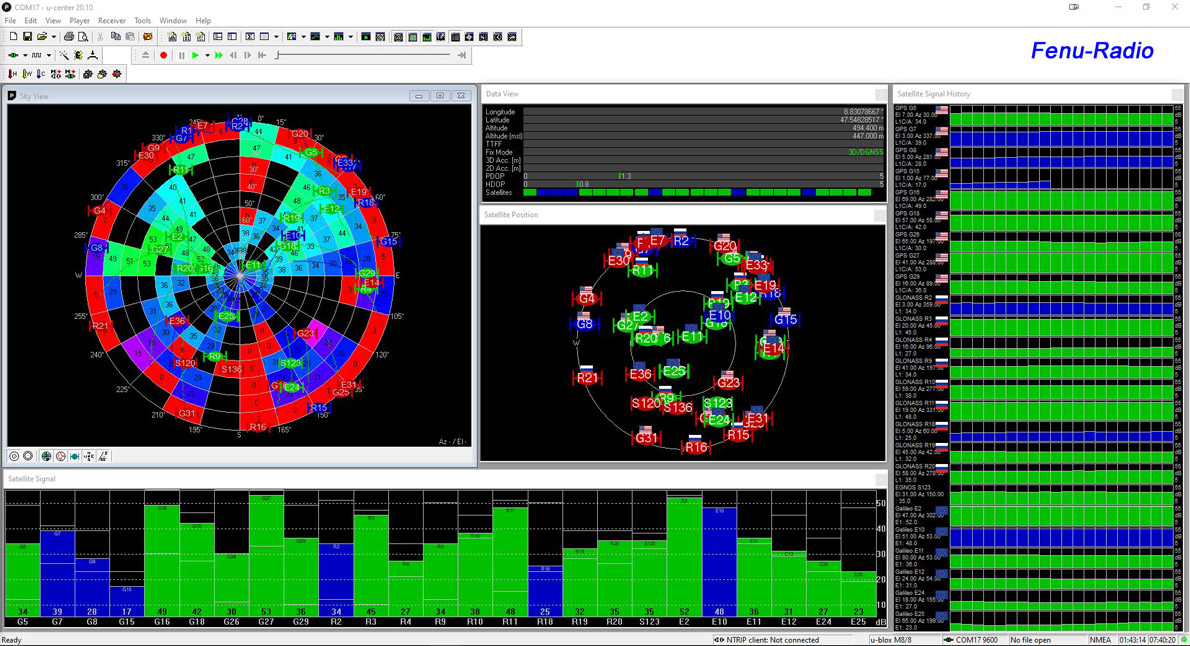
Conclusion:
The Elad FDM-S3 is a top predator among SDR's! Currently there is no
black box SDR that offers reception from 9KHz - 108MHz in top
quality. Provided that bandpass filters are installed. The
processing quality is top class and leaves nothing to be desired. In
addition, the excellent FM reception, the advanced Gnss functions
and the very fair price. The S3 should certainly be interesting for
professional reception applications. The only shortcomings are the
very high operating temperature with the built-in "OCXO" option and
the missing bypass function for the bandpasses in the SW2 software.
The tip of the iceberg has become a bit wider. The S3 is on VLF, LW,
MW and SW on par with the Winradio G33DDC and counts as of now to my
reference devices!
Absolute top class.
posted 24.07.2022



Downconverter
Module (DCM)
For reception above
108MHz, Elad has developed the Downconverter Module (DCM). This
extends the frequency range up to 4000MHz. The S3 thus offers a
continuous reception range from 9KHz to 4000MHz!
The DCM was announced in 2020. Due to the global corona crisis and
the associated shortage of components in the electronics industry,
its delivery was repeatedly delayed. Now the wait is over and the
DCM is available. Albeit in small quantities. At the time of testing,
the DCM had not yet been published on the Elad website.
|
-- Frequency range: VHF, UHF, SHF: 108MHz -
4000MHz
-- Compatible software: Elad SW2 & SDR
Console V3
Scope of delivery:
-- Elad Downconverter Module
-- USB3 cable for internal connection in S3
-- Switch-Board |
The downconverter
(DCM) with the switch board can be seen below. The switch board
switches the receive path in S3 depending on the frequency when the
DCM is active.
As you can see from
the pictures below, the DCM is very robustly built. The aluminum
housing is milled from the solid and weighs 1kg. There is of course
a reason for this. The higher the frequency, the better the RF
shielding of the individual circuit boards must be.
Blockdiagram from
the
DCM Front-End

Experience with
the Downconverter Module
The DCM is offered by Elad as an option for the S3. It can be
ordered together with the S3 or installed separately. However, Elad
expressly recommends sending in the S3 for installation of the DCM.
The reason for this was poor installation by the user. This led to
malfunctions in the devices. So you need a bit of skill to install
the DCM yourself. I installed the DCM and the switch board myself.
For the whole thing to work, the DCM must be activated in the SW2
software. To do this, go to the settings under the "Advanced" tab.
There you will find the settings "FDM-S3 Downconverter Module".
Check the "Enable Downconverter & Serial Number" box and then click
"Search". If the DCM is found, click on "Yes, Apply and Close". The
DCM should then be ready.

Reception
I have been using the DCM for almost two years and have gained a lot
of experience with it. I used the Dressler ARA2000 clone from Heinz
Stampfl (HB9KOC) as an antenna. This replica worked much better than
the old original. Heinz built the amplifier with the latest
low-noise and large-signal-resistant amplifier chip. I rebuilt the
actual antenna according to the old model. The frequency range of
this antenna is 50 - 2000MHz. So it does not cover the entire
frequency range of the DCM. Unfortunately, there were no other
antennas available for the upper frequency ranges.
So let's start in the aeronautical band.
With the 24MHz sampling rate, the entire aeronautical band can be
displayed. Interesting when you can see all the aircraft radio
traffic. But it is not possible to work with this almost 20MHz wide
spectrum/waterfall display. It is better to switch to a smaller
sampling rate. E.g. 384KHz. This gives you a detailed overview of
the transmitters. With the switchable and very low-noise
preamplifier of the DCM, very weak signals can still be brought out
of the background noise. Impressive! At no time did I notice any
spillover from the underlying FM band. Regardless of whether
preselection was switched on or off. On the comparator, the Airspy
HF+ Discovery, I could hear and see faint VHF spillover at certain
points.Further into the 2m amateur radio band. My reception is not
good for this frequency range. It took a long time before I was able
to record a few stations in this band. Thanks to overreach, I was
even able to pick up a few stations in USB from Sweden. That worked
very well. Unfortunately, the NFM playback of the SW2 software is a
bad! The audio always sounds overdriven and makes listening
difficult. Only with the equalizer can the overdriven audio be
attenuated somewhat. Elad has known about this problem for a long
time, but hasn't done anything about it yet.
The Airspy HF+ Discovery was again used as a comparison device. The
reception of both devices was pretty much the same. The only
difference was that the NFM playback of the SDR# software was much
better than that of the SW2.
Below: The entire
aviation radio band at a glance.

Weather satellites
The weather satellite band is just above the aeronautical band. To
receive the Noaa satellites, for example, you don't even need a
special antenna. With the ARA2000 replica, reception was
surprisingly good when the satellite flew over the area.
Below: Noaa weather satellite reception.

DAB+ frequency band
Digital Audio Broadcasting, or DAB+ for short, broadcasts between
174 and 230 MHz. Although it is easy to receive, it is not audible!
This is because the SW2 software from Elad does not offer DAB+
decoding. This is a great pity, as the DCM would offer this option.
Below: Part of the DAB+ frequency range.
Over 230MHz
Unfortunately, I lived in a kind of "valley basin" that did not
really allow reception of high frequencies. 70cm amateur radio and
everything else above that was difficult or impossible to receive.
You would have to live on a hill with a wide panoramic view for
that. Due to the lack of a suitable residential location and the
lack of special antennas for the GHz range, I had to end the test of
the DCM.
Conclusion:
The downconverter (DCM) is an enrichment for the Elad FDM-S3 and is
aimed more at specialists. The sensitivity and the large signal
behavior were excellent during the entire test phase. Nevertheless,
there were a few minor issues that affected operation and comfort.
The first thing I would like to see with this huge frequency range
is a search function that allows you to scan a pre-programmed
frequency range. In other words, a kind of scanner function. The
competitor SDR# offers such a function as a plug-in. The other
shortcoming is the audio playback in NFM mode. This is simply poor
and should be corrected by Elad.
The DCM costs about the same as the FDM-S3.
Unfortunately, I was unable to give the DCM the necessary run-out to
be able to test it at the very high frequencies.
Posted:
24.12.2023



|

.jpg)
.jpg)
.jpg)
.jpg)

.jpg)
.jpg)


.jpg)

.jpg)
.jpg)

.jpg)




.jpg)
.jpg)

.jpg)




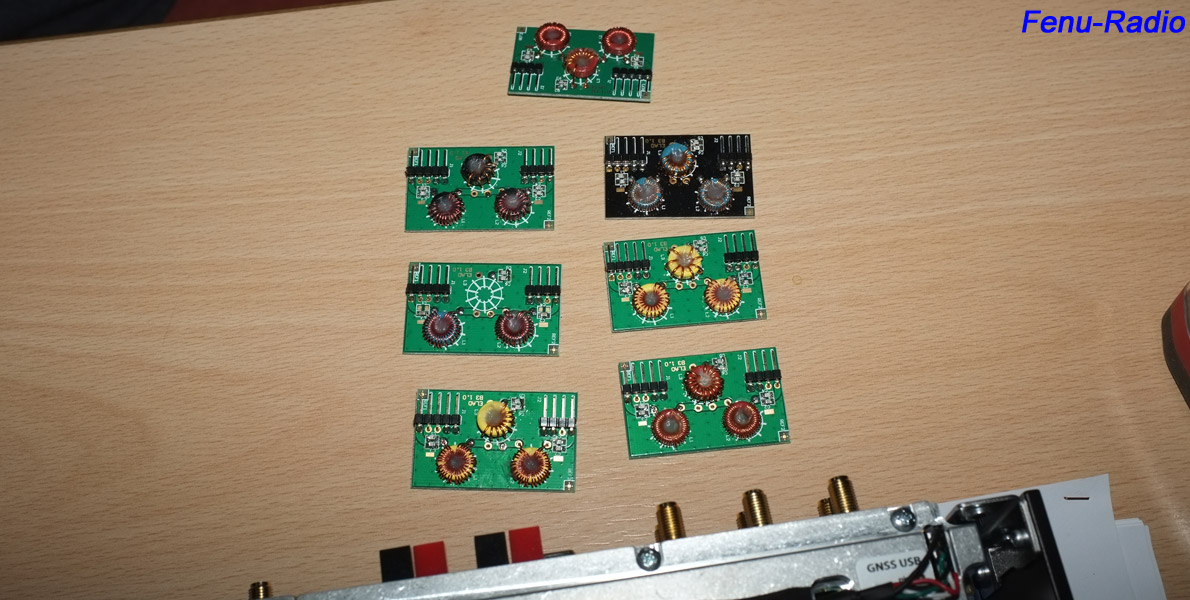













.jpg)
.jpg)
.jpg)

.jpg)

.jpg)
001.jpg)
001.jpg)
001.jpg)
001.jpg)

.jpg)







